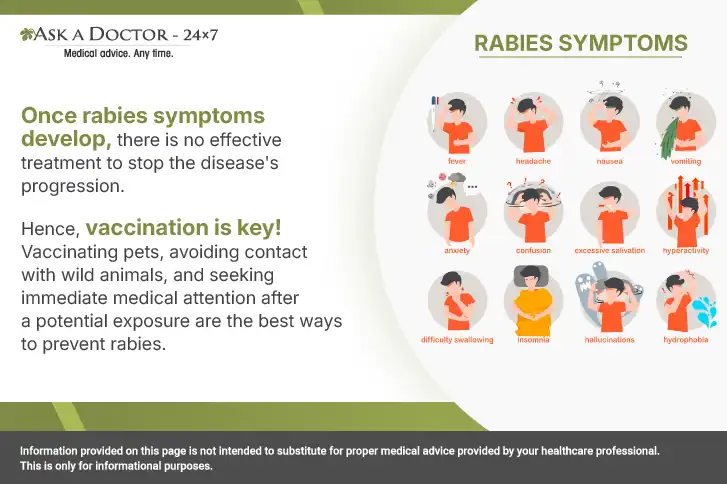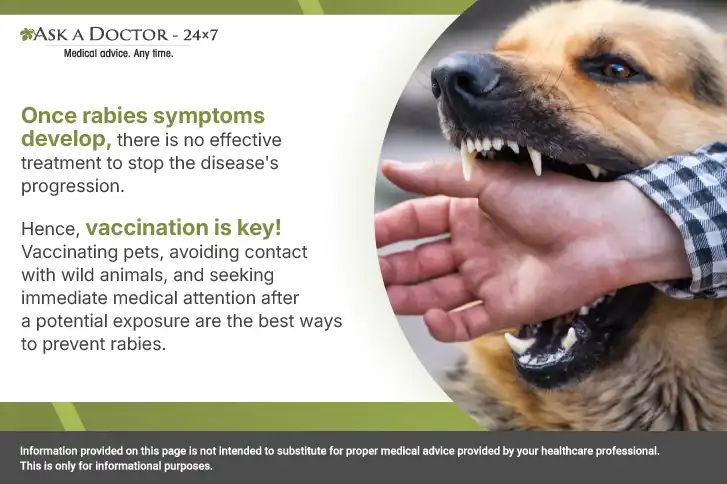What Happens If A Human Gets Rabies And Steps To Stop Rabies Exposure
Rabies is a vaccine-preventable, viral disease caused by the RABV virus that affects the central nervous system (brain and spinal cord). Rabies is typically transmitted to humans and animals through the saliva of an infected animal, via bites, scratches, or direct contact with mucous membranes (such as the mouth, eyes, or open wounds). Rabies is most commonly found in bats, skunks, raccoons, foxes, monkeys, dogs, and cats. Other animals, including your pet animals, can become infected. Almost all cases of rabies are deadly once clinical signs manifest.
In this blog, we will explore rabies exposure in humans and how to prevent the disease before it proves fatal.
Is Rabies contagious?

Rabies is a viral disease caused by the RABV virus. It is not contagious from person to person but is transmitted from animal to human. The most common way for the virus to spread is through animal bites. However, it can also spread if an individual's eyes, nose, mouth, or an open wound (such as a scrape or scratch) comes into contact with the animal's saliva (spit).
What Happens if a Human Gets Rabies?

Below are the consequences that can happen to any human if he or she contracts a rabies infection:
Incubation Period:
The time between exposure (a bite from an infected animal) and the appearance of symptoms. This is the period when the rabies virus travels to the brain. The incubation period can range from a few days to several months, depending on the location of the bite and the amount of virus involved. The average incubation period of rabies is typically 2-3 months. People don’t have any symptoms during this time. Note: If people receive rabies treatment early in the incubation period, they won’t get rabies.
Prodromal Stage:
The prodromal phase begins when the rabies virus has entered your nervous system. It shows first symptoms as your immune system tries to fight back, causing flu-like symptoms like fever, headache, and exhaustion. Additionally, due to the nerve damage, the bite site may cause unusual or unexplained tingling, pricking, itching, or burning sensations. The duration of the prodromal stage is two to ten days. When rabies reaches this stage, there are no proven cures.
Neurological Phase:
In this phase, the rabies virus damages your brain and spinal cord, seriously harming the nervous system. It has two forms:
- Furious rabies: It is characterized by hyperactivity, agitation, disorientation, hallucinations, hydrophobia (dread of water), aerophobia (current of air), and heightened sensitivity to light and sound.
- Paralytic rabies: It is characterized by muscle weakness and paralysis, which are symptoms of paralytic rabies, which develops more slowly and frequently begins near the bite site. A coma eventually sets in.
- Coma and Death: In the final stages of a rabies infection, people enter a coma, leading to death, typically within days of coma onset.
Steps to Stop Rabies Exposure
Once the rabies symptoms set in, there is no effective treatment to stop its progression. Hence, prevention is vital to prevent the disease in the following ways:
- Getting medical help right away: If someone is bitten by an animal that may be infected with rabies, seek immediate medical attention. It is essential to properly clean the wound with soap and water or preferably with a diluted povidone-iodine solution and eventually get the rabies vaccine and immunoglobulin (if necessary).
- Prophylaxis: Medications can prevent an infection from traveling to your brain if you’ve been exposed to rabies. This involves postexposure prophylaxis (PEP), including the rabies vaccine and immunoglobulins. Over 14 days, your healthcare provider will administer four vaccine shots to you. The rabies shot is given at the time of the first medical visit, followed by doses on days 3, 7, and 14. You will only require two shots if you were previously immunized before exposure.
- Educate: Recognize that stray and wild animals can spread rabies. Children should be taught to stay away from unfamiliar animals. Make sure that your dogs and cats are vaccinated.
- Other considerations: Never leave your pets unattended. Verify that your pets' immunizations are up to date. Avoid contact with wild or stray animals. Avoid touching dead animals; instead, report stray, sick, and injured animals to local animal control authorities or law enforcement officials.
Conclusion
Rabies is a viral infection that spreads primarily through bites or scratches from an infected animal. It affects the central nervous system, and if treatment is not obtained before symptoms appear, it can cause severe brain damage and even death. Rabies is preventable; if you’re exposed, you can get a vaccine to prevent rabies before symptoms begin. Seek your healthcare provider as soon as you are bitten by an animal or exposed to one suspected of having rabies. Your doctor will assess the situation and determine if a series of rabies vaccines or potentially immunoglobulin is required. Always remember that prompt action is important after potential exposure, as the disease is invariably fatal after symptoms manifest.
If you have any questions related to rabies, you can Ask an Internal Medicine at Ask a Doctor - 24x7. Also, you can check with our experts, like a neurologist, for an expert opinion.
Recently Answered Question Related to Rabies
- Will Rabies Injection Be Effective After 5 Years?
- Rabies Injection Will Be Effective Even If Taken After A Delay?
- Is It Safe to administer the Rabies Vaccination After 10 to 20 Minutes From Refrigeration?
- Is It Safe To Take Amoxicillin While Taking Rabies Shots?
- Post Rabies Vaccination For Dog Bite: Should Alcohol Consumption Be Avoided?
- Does the Rabies Vaccine Cause Fever, Headaches, and Body Aches?
- Suggest Dosage For Anti-Rabies Vaccination
- Do Open Wounds Exposed To Stray Dogs Require A Rabies Injection?
- Can Rabies Be Contracted Through Accidental Skin Contact With A Dead Animal's Brain Matter?
Disclaimer: Information provided on this page is not intended to substitute for proper medical advice provided by your healthcare professional. This is only for informational purposes.
Ask a Specialist
Recent Questions


